We may earn a commission from links on our site, but this doesn’t affect our reviews. Learn more.
Hedge With Crypto is an independent publisher that provides objective and free content. Articles on our site may include links to our partners. If you click on these links, we may earn a commission. However, our editorial content remains unbiased, reflecting our own opinions or the general information available. For more information on our company policies, read the Affiliate Disclosure, Privacy Policy, and Terms & Conditions.
How To Buy NFT’s In Australia
This information is general in nature and is for education purposes only. Hedge With Crypto does not provide financial advice nor does it take into account your personal financial situation. We encourage you to seek financial advice from an independent financial advisor where appropriate and make your own enquiries.
TABLE OF CONTENTS
Here's a quick guide on how to buy NFTs in Australia:
- Choose a crypto exchange that supports NFTs.
- Create an account.
- Deposit AUD.
- Buy Ethereum (ETH).
- Browse the NFT marketplace.
- Buy the NFT.
How To Buy An NFT In Australia – Full Guide
Step 1: Compare and choose an NFT platform
The first step to buying NFTs within Australia is to compare the available marketplaces and choose the best option. There are several types of platforms available, but for beginners, using a centralized crypto exchange is a suitable option as they can convert AUD into cryptos such as Ethereum, Solana, and Tether, which can be used to buy an NFT on the same platform.
For this guide, we will walk users through how to buy NFTs via Australia’s most popular cryptocurrency exchange, CoinSpot. However, this is not a direct endorsement of CoinSpot, and users may prefer alternate methods or platforms for buying NFTs. The process of using CoinSpot is quite simple and perfect for beginners.
Related: The Most Expensive NFTs Sold
Step 2: Register an account
Creating an account on CoinSpot, if you still need to do so, is easy. It follows the same process as most other cryptocurrency exchanges in Australia. First, navigate to the CoinSpot website and select “Register”, or enter your email and “Get Started”. Next up, enter a “strong” password and add a mobile phone number. Verify either the email or phone number (or both) submitted, and the account will be created.
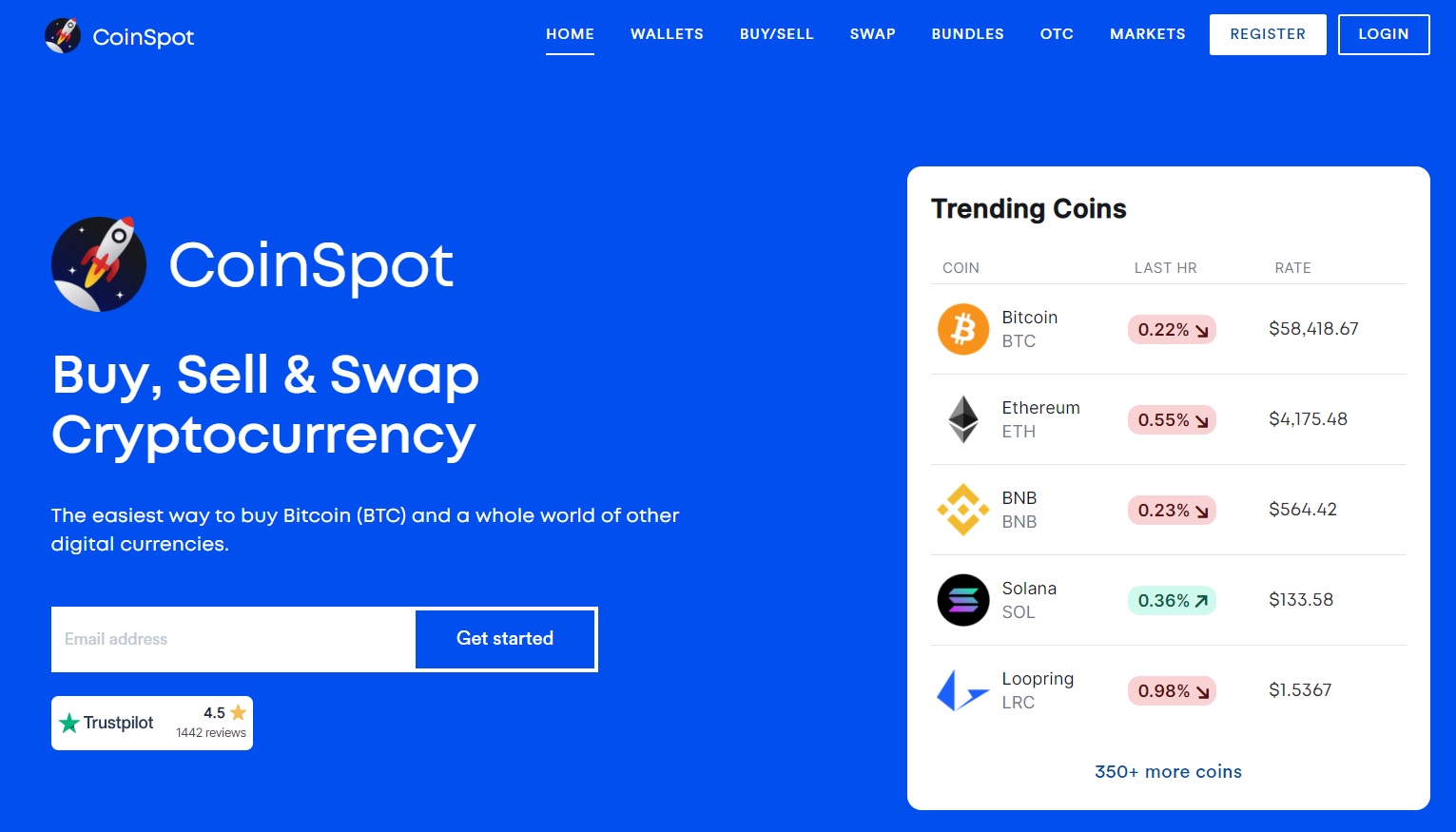
As a trusted, AUSTRAC-registered exchange, CoinSpot has certain KYC and Anti-Money Laundering (AML) requirements. This means they require each customer to provide proof of identity before depositing fiat currencies like AUD onto the platform. To pass KYC, new accounts must provide images of government-issued documentation (such as a driver’s license or passport) and basic residential information.
The KYC process is automatic and will usually take only a couple of minutes. Once an account is verified, it is ready to buy NFTs on CoinSpot!
Step 3: Deposit funds
CoinSpot is one of the more versatile Australian exchanges in terms of deposit options. Customers have many choices for instant and free AUD (or other supported fiat currency) deposits onto the platform. These include:
- POLi (0% fee, instant)
- PayID (0% fee, instant)
- BPAY (0.9% fee, 0-2 business days)
- Cash deposit (2.5% fee, instant once deposited at location)
- Debit card (2.58% fee, instant)
- Direct deposit (0% fee, instant)
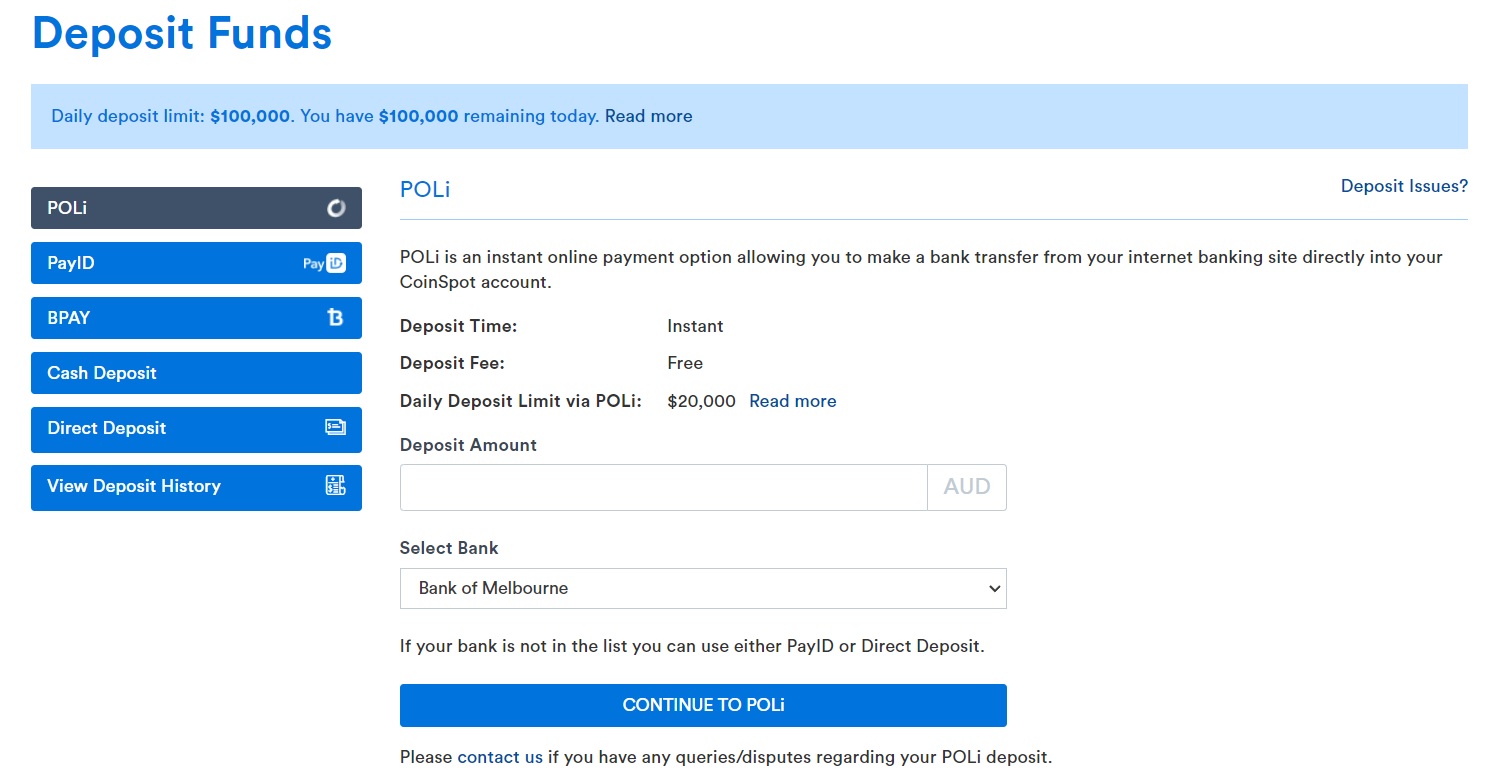
Choose a payment method to deposit funds. Alternatively, existing crypto holders can transfer digital assets to a CoinSpot wallet that can be used to buy NFTs. This can be done by withdrawing funds from another exchange (or wallet) and transferring them to a CoinSpot address. Fees will be incurred depending on the blockchain used.
To do this, customers can find the unique wallet address for supported digital currencies by navigating to “Wallets” and clicking on the desired asset. From the wallet menu, select “Receive”, then “Generate Deposit Address”. Funds can then be sent from a different wallet to fund the CoinSpot account.

Step 4: Convert funds to ETH
The next step is buying Ethereum with AUD on CoinSpot. To do this, simply navigate to CoinSpot’s Buy/Sell page, and scroll down to Ethereum. Click “Buy ETH” and input the desired amount of Ether. This can be less than the AUD deposited but not the same or more (as a hefty 1% fee must be factored in). Confirm the transaction, and the ETH will be transferred to the account’s Ethereum wallet.
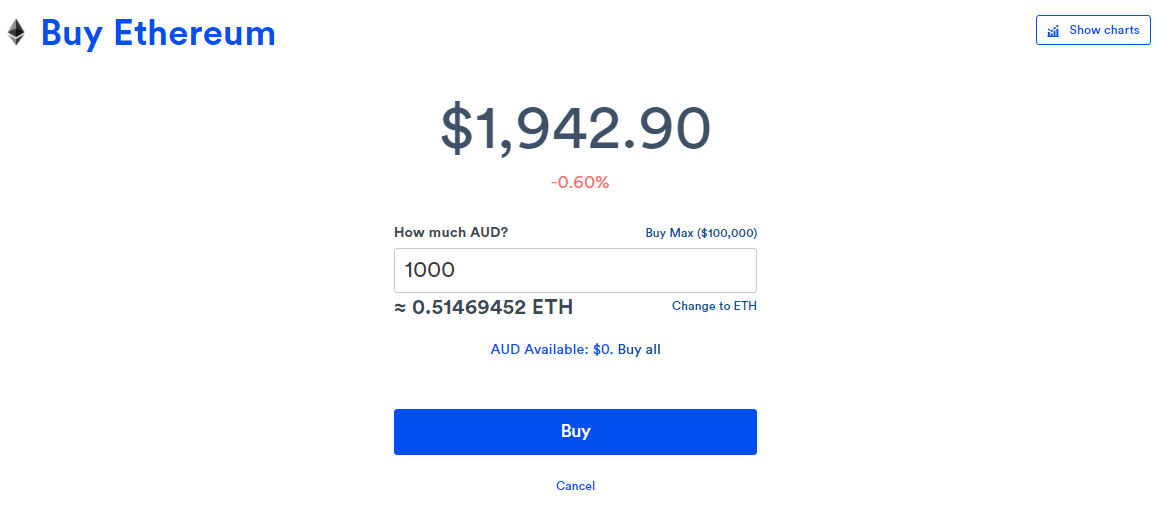
Step 5: Navigate to the NFT Marketplace
CoinSpot has various collections that users can scroll through. These include some high-floor price, blue-chip NFTs such as Bored Ape Yacht Club, Meebits, and Azukis. The marketplace also hosts new collection drops, particularly highlighting Australian artists when possible.
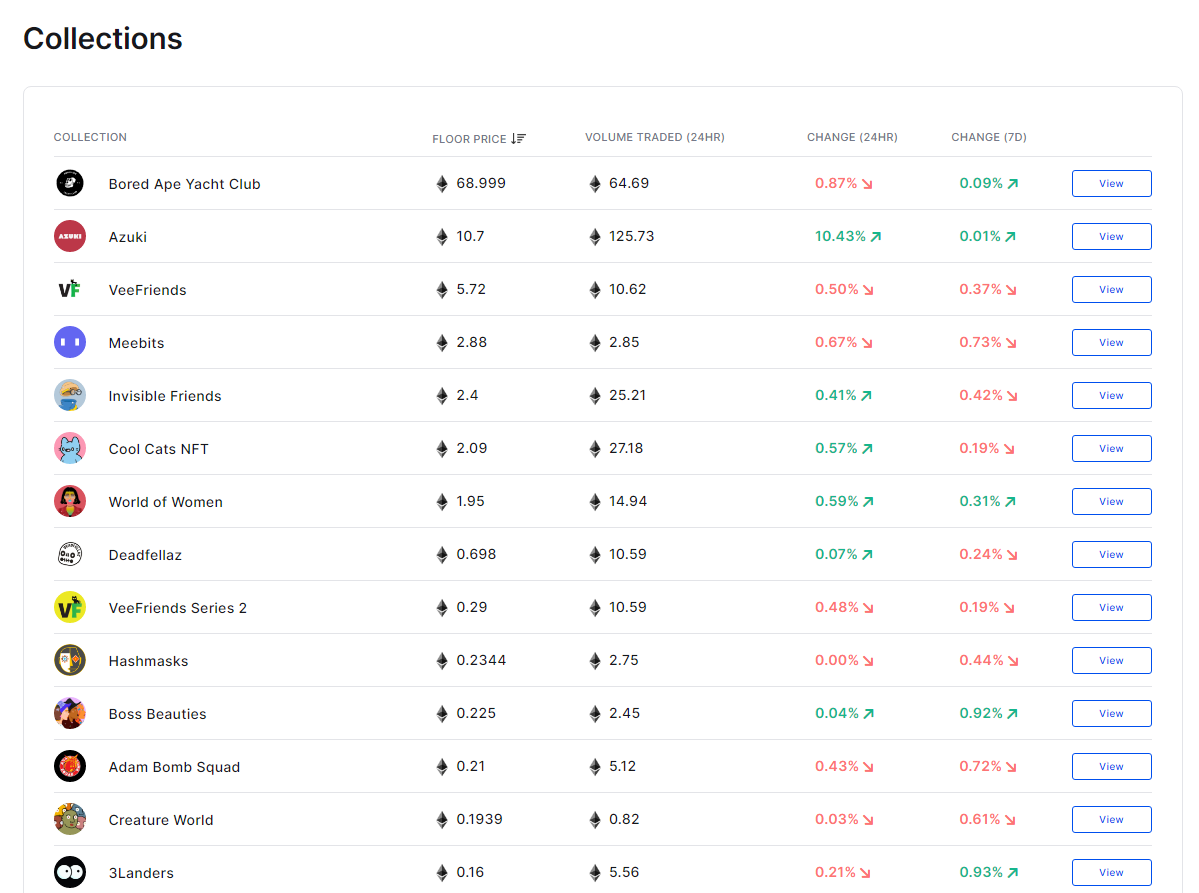
To browse a specific collection, click “View”. This will bring up whatever NFTs are for sale within the selected collection. The assets can then be sorted based on attributes, so if a customer was looking for a certain NFT in an Ape costume, they could browse for assets with those characteristics.
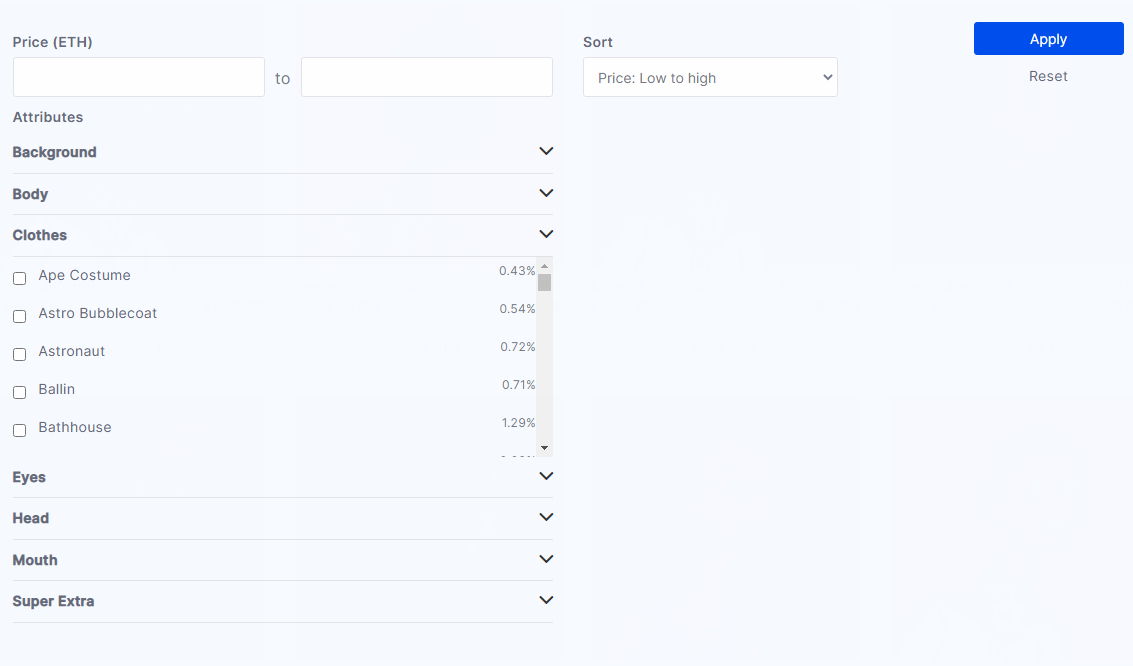
It’s always a good idea to consider the NFT’s price, scarcity, utility, collection popularity and creator before deciding which to invest in. Rarer digital artworks from popular collections will nearly always be more valuable than NFTs with mostly “common” traits.
Step 6: Buy the NFT
Now that an NFT has been selected, it’s time to buy it. This process is very simple on CoinSpot. All customers have to do is “View” the desired NFT, and then on its information page, select “Buy Now”. As long as the account has enough ETH (or other assets) to purchase the NFT, including gas fees, all that’s left is to review and confirm the NFT transaction.
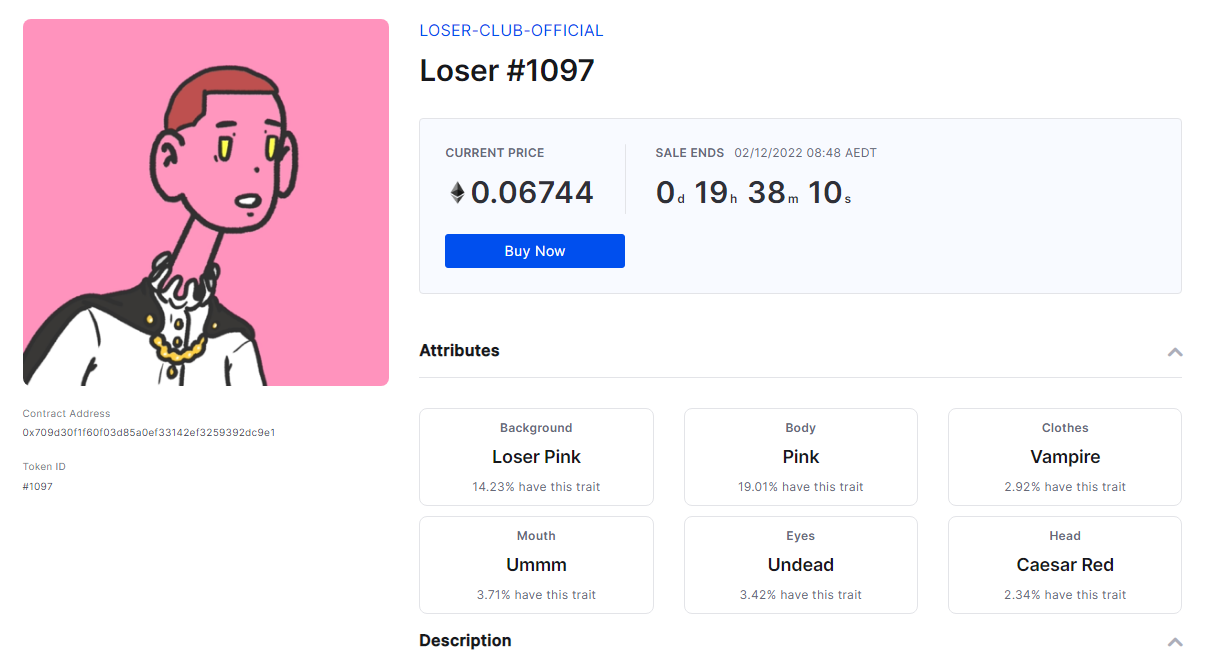
Once confirmed, the NFT will be transferred directly to CoinSpot’s native non-fungible token wallet. This is a unique feature of the exchange, as some competitor exchanges in Australia will require the NFT to be transferred to a third-party wallet. However, transferring the NFT to a supported crypto wallet with a high level of security is recommended.
Explaining The Basics of NFTs
NFT stands for non-fungible tokens. A non-fungible asset is any good or service that cannot be exchanged for the same asset at the same price. Think about a used car or a house – no two of these are ever the same, and each has its unique value. Conversely, an asset such as Bitcoin or an Australian five-dollar note is an example of fungibility. People can exchange two five-dollar notes or one Bitcoin for another, and their value will remain the same.
It’s worth remembering that NFTs are only representations of ownership. They do not necessarily mean you own the underlying asset. As such, NFTs are used to digitally represent the ownership of a unique asset that cannot be interchanged. In certain instances, though, the above NFT might entitle its holder to an ownership stake in the original asset and a portion of any royalties earned. NFTs can represent nearly anything:
- Digital media files like MP3s (music) and JPEGs (art)
- In-game items
- Tokenizing real-world utility items (a concert ticket)
- Fractionalization of real-world assets (buying 10% ownership of a business)
- Digital representation of physical collectibles (rare posters, whiskey barrels)
Types of NFT Marketplaces
Initially, most NFTs had to be purchased from decentralized, peer-to-peer marketplaces designed to exchange these digital assets. However, the ecosystem has evolved substantially since then. Australians now have ample opportunities to build their NFT portfolios through various NFT platforms, including Peer-to-peer marketplaces, curated marketplaces, and cryptocurrency exchanges.
Peer-to-peer (P2P) NFT marketplaces
The majority of popular NFT marketplaces are decentralized, P2P platforms. These exchanges are typically built atop a blockchain such as Ethereum, allowing registered users to create (mint) their digital assets directly via the platform. Due to their decentralized, blockchain-integrated nature, P2P NFT marketplaces often stock a massive range of NFTs for users to browse. Popular P2P marketplaces include OpenSea, Rarible, LooksRare, Immutable X and Magic Eden (Solana).
Curated NFT marketplaces
Curated NFT marketplaces are like browsing and bidding at an art gallery. Most of the NFTs featured on these platforms are hand-picked by the business that owns the marketplace. They often try to showcase a particular aesthetic or theme in their NFT collections, such as high-end artwork or theme-related assets. Popular curated marketplaces include SuperRare, NBA Top Shot and SoRare.
Centralized exchanges (CEXs)
Popular centralized cryptocurrency exchanges are adding native support for browsing and buying NFTs. This can be done in two ways:
- The platform opens up its own curated or peer-to-peer marketplace (such as Crypto.com NFTs), or,
- The platform partners with a third-party provider such as OpenSea to offer the same NFT collections through the exchange platform
In theory, CEX NFT marketplaces can be either curated or peer-to-peer. Buying digital artwork via centralized exchanges is the easiest way for beginners to get involved in the asset class. Customers can swap their fiat or digital currencies directly to ETH/SOL/MATIC and purchase an NFT, all on the same platform.
However, using a CEX may limit the number of quality NFT collections available, and these platforms typically charge more in fees for this service than their decentralized equivalents. Popular exchanges in Australia that offer an NFT marketplace include CoinSpot, Binance and Crypto.com.
Types of NFTs Can You Buy In Australia
1. Collectibles – Popular for digital artworks
The most popular form of NFTs to buy are collectibles. This includes digital art, such as CryptoPunks, Bored Ape Yacht Club and many others. The NFTs that fall under this umbrella has an extremely wide range of price floors – from a couple of cents to multi-millions. The seemingly arbitrary distribution of value can ward off many potential investors. In that sense, it’s worth considering these NFTs like any other collectible someone would buy and display on their shelves. Purchasing these items isn’t necessarily about utility, nor should it necessarily be about turning a profit.
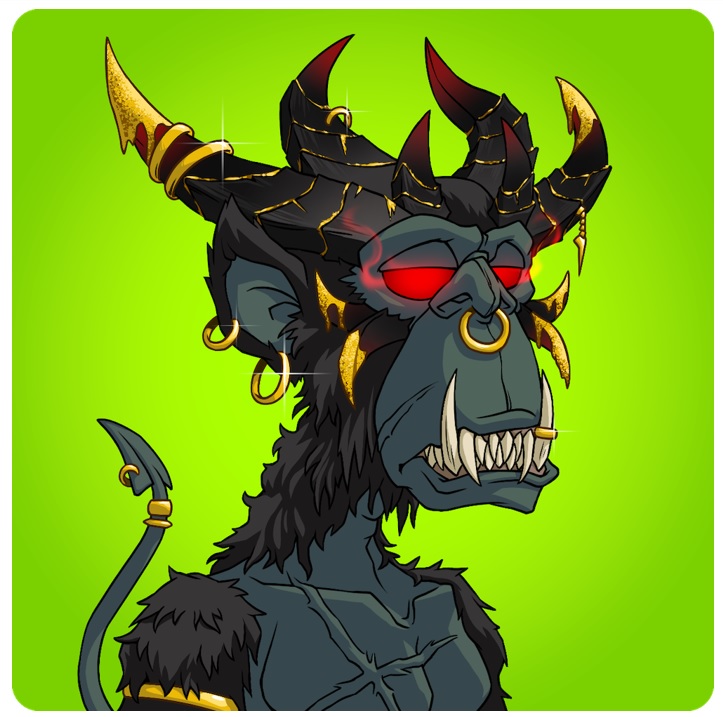
People will more often than not buy collectibles for one simple reason – because they like them. NFTs are no different. Someone might be willing to pay $300K for a Mutant Ape to flaunt their social status and feel like a semi-celebrity. Someone might pay $10 for a local artist’s digital painting of a fire truck because they like the artist. Collectibles are nearly always valued based on supply and demand. Rarer NFTs from desirable collections will always outperform common NFTs from lesser-known projects.
2. Utility NFTs – Popular for in-game purchases
Certain ‘collectible’ NFTs have innate utility, which is not their primary purpose. Conversely, utility NFTs are built with a specific function in mind. Most importantly, utility NFTs go hand-in-hand with metaverse/blockchain-based gaming. These digital tokens can be used to represent in-game items. This might include simple fashion accessories, weapons that impact gameplay, or even form the basis of an in-game economy.
For example, in The Sandbox, players can purchase LAND NFTs. Each LAND NFT denominates one plot of real estate in the game that can be customized however the user desires. If they provide an incentive, the LAND owner can even monetize their in-game space.
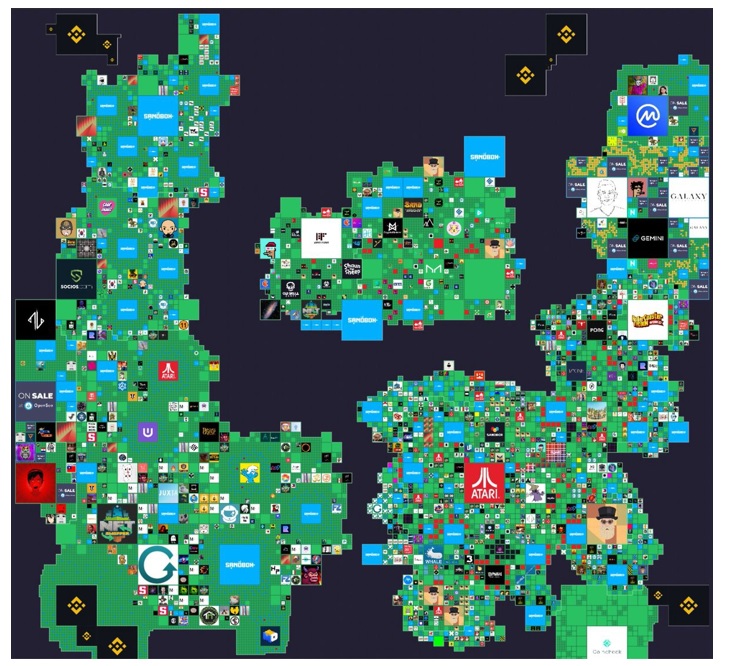
3. Tokenization NFTs – Good for real world assets
Tokenization of real-world assets using NFTs has become one of the most popular use cases of digital tokens. Essentially, tokenization refers to the digital representation of physical commodities and services. A major benefit of tokenization is solving liquidity issues, improving efficiency, and reducing the chance of fraud.
For example, buying real estate typically requires the involvement of multiple third parties, extensive paperwork, and a slew of taxes. An NFT representing a property can remove the necessity for some of these measures, particularly intermediaries like real estate agents.
The possibilities of tokenization don't end there, though. By digitally representing typically illiquid assets (like real estate, cars, etc.), these can be fractionalized and sold to different owners. Instead of needing to find one person to invest $500,000 in a property, sellers can find five people who wish to invest $100,000. Distributions and capital gains could then be fairly split among the five different token holders, as the NFT proves the proportional ownership.
What To Consider When Investing in an NFT
- The NFTs blockchain. Knowing the NFT's blockchain is a good idea, as paying in the network's native currency will usually be more efficient. Additionally, potential investors should research the underlying protocol to ensure it is a realistic and sustainable network for hosting NFTs in the years to come. Moreover, the expansion of the NFT industry has led to various smart-contract-capable blockchains introducing support for these unique tokens. Solana, Wax, Algorand, Flow, Tezos, and Binance Chain are all examples of networks that support NFTs.
- Gas fees. Buying NFTs will nearly always incur a gas fee. This fee might be charged on top of a marketplace's brokerage fee (for example, CoinSpot's 0.9%), or it may already be factored in. The fees investors will pay depend on a few things. Most importantly, the blockchain network hosting the NFT will play a major role. For example, Ethereum is the most popular smart contract and NFT network in the industry – however, the same popularity can lead to congestion and expensive gas fees. Conversely, more scalable blockchains like Solana will have less congestion, and thus, buying NFTs on these protocols will incur lower gas fees.
- NFT Characteristics and rarity. An NFT's traits go a long way to determining its rarity, which helps determine its validity as a long-term investment. For example, a Dragon avatar (1/50) wearing a gold crown (1/128) may be a better financial option than a Gorilla avatar (1/16) smoking a pipe (1/54). Marketplaces like OpenSea and CoinSpot Australia will show each NFT's specific attributes and how rare these individual characteristics are. On the flip side, it's worth remembering that rarity isn't everything – these types of NFTs should be considered collectibles. So, if an investor really likes a piece of art, its rarity shouldn't always impact their decision to buy (or not buy) it.
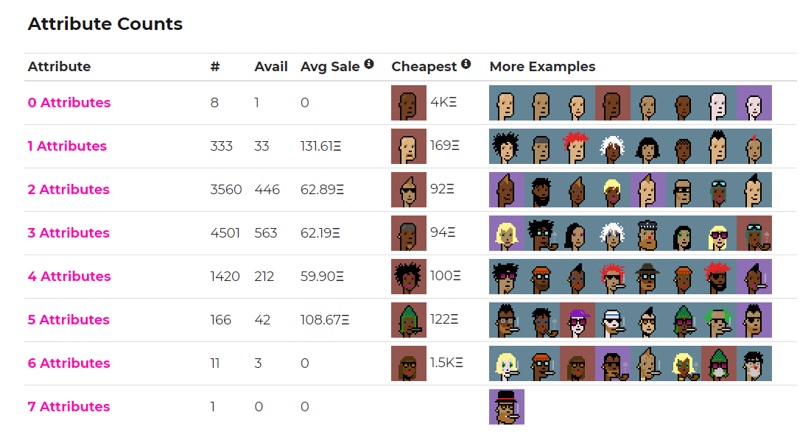
Pros & Cons of Buying NFTs
Australians considering buying an NFT collection should consider the pros and cons before making a digital purchase.
Pros of buying NFTS:
- NFTs have the potential to unlock truly democratized investment. By fractionalising illiquid, high-barrier items like vintage cars or real estate, people with less income can expose themselves to these assets
- NFTs have innate proof-of-ownership, making them very hard to steal or misplace
- NFTs can be a great way to support local content creators, and they unlock a whole new revenue stream for underpaid artists
- Collecting NFTs can be a fun alternative to trading cards, posters or pictures
Cons of buying NFTS:
- NFTs are still a novel industry and their full potential and functionality is yet to be realized.
- NFTs are very polarizing, as many in the public eye still believe them to be a scam
- NFTs experience price fluctuations akin to crypto volatility. Investments can quickly lose 50%+ in value during market downturns
- NFTs are mostly stored on the Ethereum blockchain, which is plagued with high congestion and expensive transaction fees
Frequently Asked Questions
What wallet can I buy NFTs with?
Quite a number of non-custodial wallets support storing NFTs and other digital assets. The easiest way to access NFTs is via in-app navigation of decentralized applications. Reputable wallets include Metamask, Coinbase Wallet, Trust Wallet and Exodus Wallet based on our reviews.
Can I buy NFTs without crypto?
For the most part, investors cannot buy NFTs from marketplaces without a cryptocurrency like Ethereum or Solana. NFTs that are minted on these blockchains require gas fees to be paid to facilitate the purchase. In some rare circumstances, certain curated marketplaces such as NBA Top Shot accept credit card purchases.
Do you pay taxes on NFTs in Australia?
According to the ATO, NFTs are not a form of digital currency and therefore have different tax obligations to cryptocurrencies in Australia. In general, NFTs are taxed if they are distributed or flipped as part of a business/profit-making scheme. Conversely, NFTs that are held as collectibles are unlikely to be taxable.